They contrast beautifully against the skies and are fun finds in woods or among the grass, but the various red birds can be quite challenging to tell apart if you aren’t sure what you’re looking for. Here is a comprehensive guide to identifying 10 common red birds.
10 Common Red Birds
1. Northern Cardinal
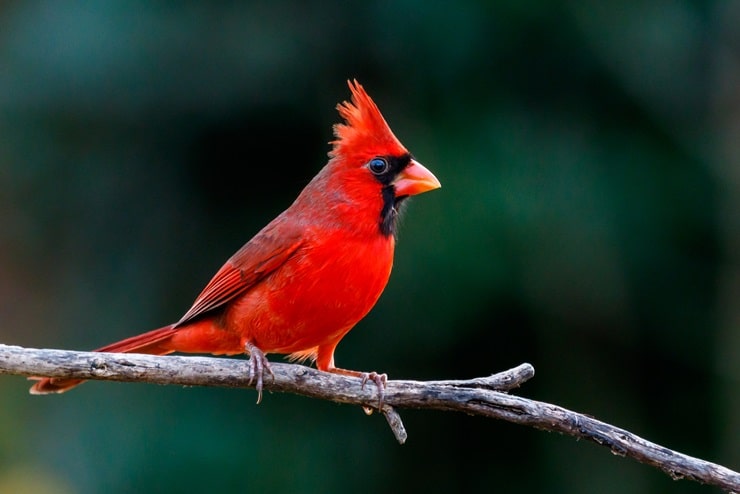
- Scientific Name: Cardinalis Cardinalis
- Size: 8.3 to 9.1 inches
- Weight: 1.5 to 1.7 ounces
- Wingspan: 9.8 to 12.2 inches
Male cardinals can be identified by their long tails, short and thick bills, prominent crests, bright red bodies, and black masks and throats. Female northern cardinals look similar while being pale brown with reddish hues on their wings, tails, and crests.
Though they prefer the east side of the United States, northern cardinals can still be found in Canada and Mexico. As for habitats, northern cardinals like to live in dense shrubs and vines near inhabited areas like parks, backyards, and forest edges.
While they prefer to eat seeds, insects, and small fruits, northern cardinals have been known to eat grains in birdfeeders.
Northern cardinals are non-migratory birds, so you will likely see them year-round if you find one in your backyard. As for nesting habits, female cardinals make the nest and have two to three broods per year with three to four eggs per brood.
The northern cardinal is one of the few American songbird species where the female sings, most commonly when she’s on a nest.
2. Vermilion Flycatcher
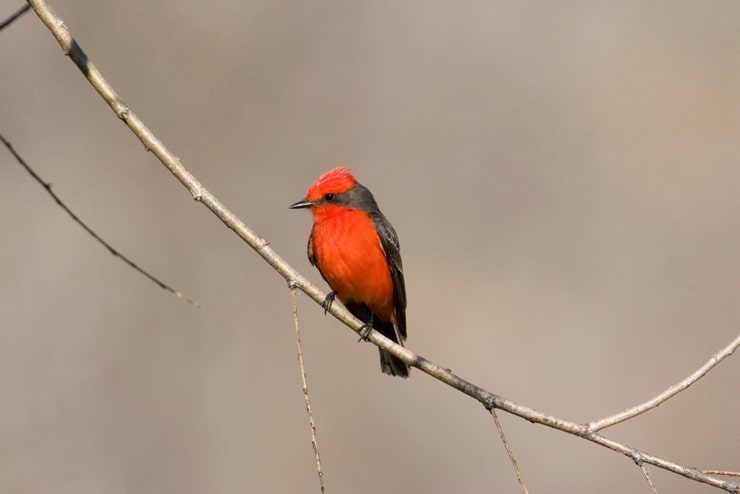
- Scientific Name: Pyrocephalus Obscurus
- Size: 5.1 to 5.5 inches
- Weight: 0.39 to 0.49 ounces
- Wingspan: 9.4 to 9.8 inches
Male vermillion flycatchers have short tails, stout bodies, and thin beaks with mostly bright red bodies and brown to black wings. Females tend to have brown bodies and heads with white breasts and reddish bellies.
You can typically find vermillion flycatchers in open shrubby areas, especially in scrubby deserts, riverine woodlands, lightly cultivated land, and tropical lowlands. They primarily live in Mexico while migrating to southern parts of the United States when they plan on breeding.
As their name implies, vermillion flycatchers’ diets primarily consist of insects such as beetles, grasshoppers, wasps, flies, and other bugs.
Female vermillion flycatchers make nests in forks of trees and tend to have two broods per year. Each brood typically has three eggs but always has two to four.
Though they are not migratory birds, vermillion flycatchers are prone to wander outside of their living areas and have been seen as far as Minnesota, Maryland, and British Columbia.
3. Summer Tanager

- Scientific Name: Piranga Rubra
- Size: 8 inches
- Weight: 0.9 to 1.1 ounces
- Wingspan: 11 to 12 inches
The male summer tanagers have full bodies, thick but blunt-tipped bills, big heads, and bright red feathers. Females are yellow all over and can be distinguished by their pinkish or horn-colored bills.
Summer tanagers tend to be found on the northern side of South America and throughout Mexico and Central America, but they tend to migrate to the southern United States to breed. Ones who live farther north tend to nest in open forests while ones farther south make homes in trees near streams.
The diet of a summer tanager consists mostly of insects. During the summer they are known to eat beetles, caterpillars, cicadas, grasshoppers, flies, occasionally spiders, and wasps and bees.
Female summer tanagers make nests on horizontal branches of trees for the females to lay their eggs. Typically, a female only has one brood during the summer with three to five eggs in the brood.
Though their diets are mainly insects, you can sometimes spot a summer tanager eating berries from your bushes!
4. Scarlet Ibis
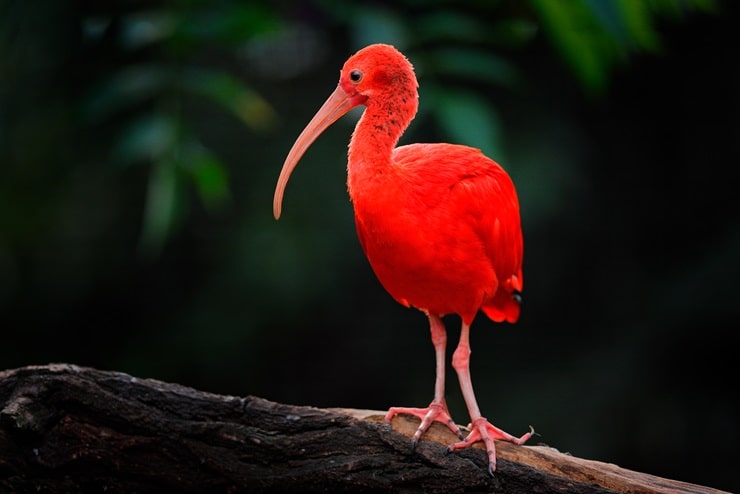
- Scientific Name: Eudocimus Ruber
- Size: 21.7 to 24.8 inches
- Weight: 3.1 pounds
- Wingspan: 21.3 to 24 inches
Both female and male scarlet ibises have bright red bodies with black-tipped wings and long, slender legs and necks. Their bills are also long and curve toward the ground.
Due to their diet, most scarlet ibises are found near the coastline on the northern edge of South America. They like to make homes along the shorelines but will gather in freshwater areas as well as in mudflats, marshes, and mangroves.
Like most other birds, scarlet ibises like to eat insects, like beetles, but also like bigger sources of food. Scarlet ibises have been known to eat mollusks, shrimp, small fish, amphibians, and even small snakes.
Both male and female scarlet ibises help make the nest for the female to use. Females will have one brood yearly that consists of three to five eggs.
The red color that makes up scarlet ibises comes from their diet and is not a natural color.
5. Red-Billed Firefinch

- Scientific Name: Lagonosticta Senegala
- Size: 3.5 to 3.9 inches
- Weight: 0.2 to 0.4 ounces
- Wingspan: 8 inches
Male red-billed firefinches are stout-bodied with large conical bills, red plumage, brown wings, and yellow markings around their eyes. Females appear similar in stature but have more brown coloration with red patches in front of their eyes.
Red-billed firefinches span throughout different parts of Africa with the highest concentration of them being south of the Sahara desert. They prefer to make homes in the savanna choosing overgrown shrubbery or the edges of wooded areas.
Many red-billed firefinches eat seeds and grain as the main portion of their diet but supplement it with bugs like small crickets, mealworms, waxworms, grub, and other native bugs.
Female red-billed firefinches have three broods per year with three to four eggs in each brood.
Nests of red-billed firefinches often end up being hosts for village indigobirds who also lay eggs for red-billed firefinches to raise as their own.
6. Hepatic Tanager
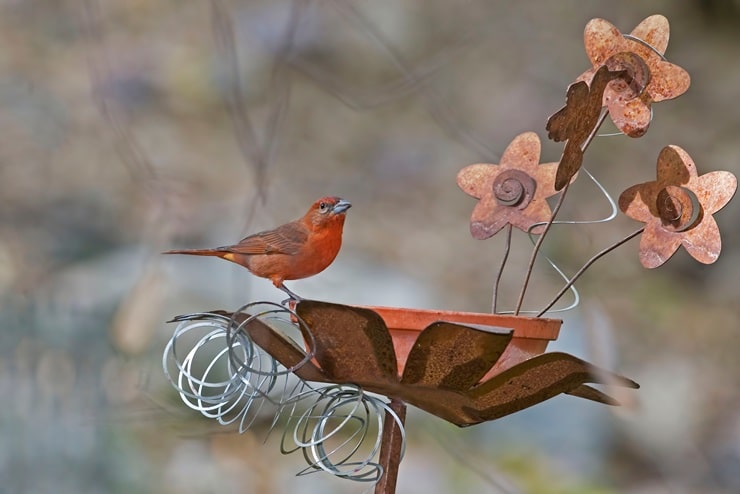
- Scientific Name: Piranga Flava
- Size: 3.5 to 7.9 inches
- Weight: 0.8 to 1.7 ounces
- Wingspan: 8 inches
Adult male hepatic tanagers are described as large and chunky with silver bills, gray to black backs, red bodies, and gray patches around their eyes. Females are yellowish green across their bodies, slender, and dark-eyed with gray cheeks.
Mostly native to eastern South America and throughout Mexico, hepatic tanagers have been known to come into the southwestern states of the United States to breed. They prefer open pine trees and pine-oak woodlands, but migrants will stop over desert oases, wooded streams, and woodlands.
Hepatic tanagers choose to feed on larger insects like caterpillars as well as berries and small fruit, especially in the summers.
While females will build most of the nest, males will bring materials to her and help defend it by singing. Female hepatic tanagers have one brood per year with three to five eggs in them.
Despite being the most widespread bird in their genus, hepatic tanagers are the least studied with only 106 hepatic tanagers being banded in 2002.
7. Red Crossbill
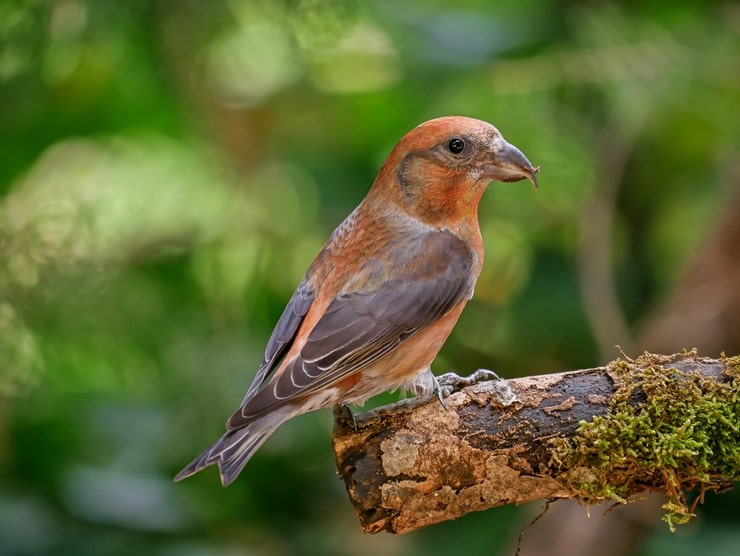
- Scientific Name: Piranga Flava
- Size: 7.9 inches
- Weight: 1.4 to 1.9 ounces
- Wingspan: 10.6 to 11.4 inches
As the name suggests, all red crossbills have a crisscrossed bill, but males have red bodies with dark brownish-red wings while females are yellowish with dark speckles on their bodies and brown wings.
While red crossbills can be seen as far north as Alaska and as far south as Mexico, most of these birds can be spotted through Canada and the northwestern United States. They like conifer forests high in the mountains but can be found in towns and backyards as well as south and east of their normal range if interrupted.
Red crossbills prefer seeds from conifer trees but will eat anything from bugs to berries and seeds of other plants. Some have even seen eating weeds.
The females of the red crossbills build the nest. They also tend to have two broods per year with three to four (sometimes five) eggs per brood.
Red crossbills rely on conifer seeds so much that finding them in large quantities can cause them to go into another breeding season (even in deep winter) to have food for their young.
8. Red Warbler

- Scientific Name: Cardellina Rubra
- Size: 4.9 to 5.3 inches
- Weight: 0.27 to 0.31 ounces
- Wingspan: 10.6 to 11.4 inches
Both the male and female red warblers are red all over their bodies with a white or gray patch on both sides of their faces, darker wings with pink edges, red-brown legs, and pink bills. Female red warblers tend to be a bit more orange in color.
Native to the highlands of Mexico, the red warbler likes to make their homes humid or semi-humid pine trees, pine-oak forests, and fir forests. They have been noted as far north as Arizona in 2018 but those sightings are uncharacteristic.
Red warblers are insectivores, meaning they primarily eat insects. They will travel to the middle and lower levels of trees to pick insects out of bark or pine needles on the forest floor.
The nest for red warbler eggs is built by the female. Once per year, a female will have a brood of eggs, typically consisting of three eggs but sometimes a female will have four.
There are three subspecies of red warbler that are found in no distinct patterns but are distinguishable by the color of patches on their heads.
9. White-winged Crossbill
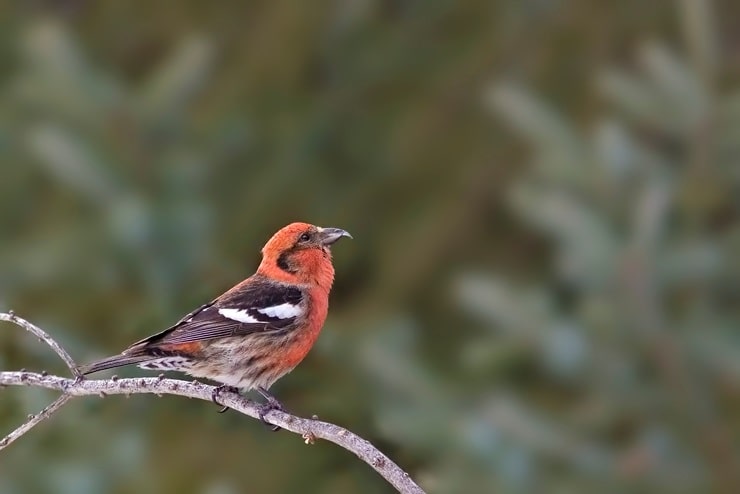
- Scientific Name: Loxia Leucoptera
- Size: 5.9 to 6.7 inches
- Weight: 0.8 to 0.9 ounces
- Wingspan: 10.2 to 11.0 inches
Both male and female white-winged crossbills have stocky bodies with crisscrossed bills and dark wings with two white wing bars on them. The main difference is body color as males are red and females are yellow with speckles.
Preferring a colder climate, white-winged crossbills are common in Canada and sometimes creep into northern parts of the United States. They like to make homes in forests, especially those with spruce and tamarack trees but can be found in weed fields, hemlock forests, and sometimes backyard feeders during interruptions.
Just like their relatives, white-winged crossbills rely on conifer seeds and supplement their diets with other seeds, weeds, berries, and insects when they are scarce.
White-winged crossbills nest in loose colonies with females primarily building the nest alone, but males occasionally bring them materials. Female white-winged crossbills have up to two broods per year producing two to four eggs per brood.
Their reliance on conifer seeds is not exaggerated as individual white-winged crossbills can eat as many as 3,000 seeds per day.
10. Crimson Rosella
- Scientific Name: Platycercus Elegans
- Size: 10.4 to 14 inches
- Weight: 4 to 6 ounces
- Wingspan: 17.3 to 20.8 inches
There are three main colors to the subspecies of crimson rosellas which include yellow, orange, and crimson bodies with distinct blue tailfeathers, dark scalloped wings with blue edges, and blue face markings. Males are larger than females both in body and beak size.
Crimson rosellas are native to Australia with their main populations in the southwest side of the continent. They prefer old and wet forests, so they choose to make their homes in forests located on the coast or in mountains and have been found at all altitudes.
Comfortable around people, crimson rosellas will eat from backyard feeders or garden seed trays. When left to the food in nature, they choose to eat berries, eucalyptus seeds, shrubs and grasses, insects, and tree blossoms.
The crimson rosella will make a nest in the hollows of trees and both prepare the hollow for nesting. Females have one to two broods per year with four to eight eggs in each brood.
Since crimson rosellas were once very familiar with people, they will take food right out of people’s hands even if they are not tamed.
Also Read: 10 Purple Birds
